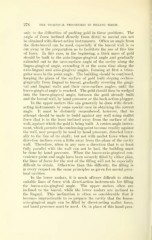Page 582 - My FlipBook
P. 582
278 THE TECHXIC.\1, PROCEDURES IN FILLING TEETH.
only to the difiSculties of packing gold in these positions. The
angle of force inclined directly from distal to mesial can not
be obtained with direct-action instruments. Often an angle from
the disto-biiccal can be used, esiiecially if the buccal wall is so
cut away in the preparation as to facilitate the use of this line
of force. In this case, in the beginning, a thick mass of gold
should be built in the axio-linguo-gingival angle and gradually
extended out to the cavo-surface angle of the cavity along the
linguo-gingival angle, extending it at the same time along the
axio-lingual and axio-gingival angles, forming at first a trian-
gular mass in the point angle. The building should be continued,
keeping the plane of the surface of gold built sloping occluso-
gingivally from lingual to buccal, gradually covering the gingi-
val and lingual walls and their cavo-surface angles, until the
bucco-gingival angle is reached. The gold should then be wedged
into the bucco-gingival angle, between the gold already built
and the buccal wall, by hand pressure or the back-action plugger.
In the upper molars this can generally be done with direct-
acting insti'uments by some special care in obtaining the correct
angle. It must be distinctly remembered, however, that no
attempt should be made to build against any wall using mallet
force that is in the least inclined away from the surface of the
wall, against which the gold is being built. A contra-angle instru-
ment, which permits the condensing point to come readily against
the wall, may properly be used by hand pressure, directed later-
ally to the line of its shaft; but not with mallet force when its
direction inclines even a little away from the plane of the cavity
wall. Therefore, when in any case a direction that is at least
fully parallel with the wall can not be had, the building must
be done by hand pressure. When the bucco-axio-gingival con-
venience point and angle have been securely filled by either plan,
the lines of force for the rest of the filling will not be especially
difficult to obtain. Otherwise than this difficulty, the filling is
in every respect on the same principles as given for mesial prox-
imal cavities.
In the lower molars, it is much oftener difficult to obtain
suitable lines of force with direct-action instruments for filling
the bucco-axio-gingival angle. The upper molars often are
inclined to the l)uccal, while the lower molars are inclined to
the lingual. This inclination is often so considerable that it
becomes impracticable to so prepare the cavity that the bucco-
axio-gingival angle can be filled by direct-acting mallet force,
and hand pressure must be used. Or, in place of this hand pres-


